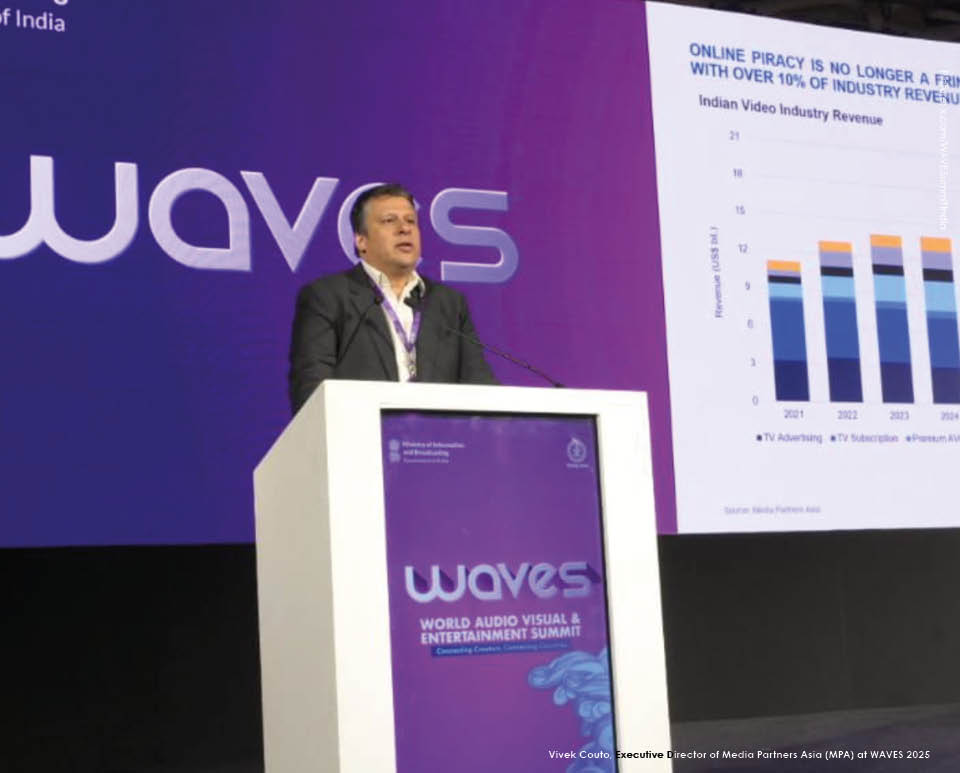
JioStar is doubling down on content investment, pouring approximately US$3.6 billion into programming this year, with plans to increase spending further in 2026, JioStar Vice Chairman, Uday Shankar, said in India at the weekend during the first World Audio Visual and Entertainment Summit (WAVES).
In 2024, the company spent INR25,000 crores/US$3 billion on content alone. In 2025, content investment will rise to INR30,000 crores/US$3.6 billion, and the number next year will be over INR32,000-35,000 crores/US$3.8 billion-US$4.1 billion.
“In three years, we have spent more than US$10 billion,” Shankar told delegates at the inaugural mega-event held at Jio World Convention Centre.
Talking on stage to Media Partners Asia (MPA) executive director, Vivek Couto, Shankar said the narrative that pay-TV was dead was false.
“Since we brought two major companies together, pay TV has added subscribers, not lost them. We’ve focused sharply, and the results speak for themselves. India continues to be an exciting pay-TV market and will be for a while,” he said.
JioStar today had half a billion people coming to the platform, “and we have a large number of people subscribing and paying for it … well over 250 million paying customers that will grow further with the IPL finals in May,” he said.
Shankar highlighted the need for much more content tailored for the Indian market with the ability to travel.
He said that while the distribution infrastructure had expanded to places with new languages and dialects, content innovation had not always matched audience expectations.
“Viewers are far ahead of where providers are. We still think that importing global content is enough. But India needs a massive volume of content tailored to Indian tastes – regional, cultural, linguistic. And ideally, it should be strong enough to travel globally,” he said.
The content environment is not without challenges.
“Theatrical in North India has taken a huge dip and Hindi movies also have taken a huge hit,” Shankar said.
“Bollywood...
JioStar is doubling down on content investment, pouring approximately US$3.6 billion into programming this year, with plans to increase spending further in 2026, JioStar Vice Chairman, Uday Shankar, said in India at the weekend during the first World Audio Visual and Entertainment Summit (WAVES).
In 2024, the company spent INR25,000 crores/US$3 billion on content alone. In 2025, content investment will rise to INR30,000 crores/US$3.6 billion, and the number next year will be over INR32,000-35,000 crores/US$3.8 billion-US$4.1 billion.
“In three years, we have spent more than US$10 billion,” Shankar told delegates at the inaugural mega-event held at Jio World Convention Centre.
Talking on stage to Media Partners Asia (MPA) executive director, Vivek Couto, Shankar said the narrative that pay-TV was dead was false.
“Since we brought two major companies together, pay TV has added subscribers, not lost them. We’ve focused sharply, and the results speak for themselves. India continues to be an exciting pay-TV market and will be for a while,” he said.
JioStar today had half a billion people coming to the platform, “and we have a large number of people subscribing and paying for it … well over 250 million paying customers that will grow further with the IPL finals in May,” he said.
Shankar highlighted the need for much more content tailored for the Indian market with the ability to travel.
He said that while the distribution infrastructure had expanded to places with new languages and dialects, content innovation had not always matched audience expectations.
“Viewers are far ahead of where providers are. We still think that importing global content is enough. But India needs a massive volume of content tailored to Indian tastes – regional, cultural, linguistic. And ideally, it should be strong enough to travel globally,” he said.
The content environment is not without challenges.
“Theatrical in North India has taken a huge dip and Hindi movies also have taken a huge hit,” Shankar said.
“Bollywood is frozen in time in terms of the nature of product it creates, while consumers have moved forward. 65% of India’s population is under 35 years of age.”
“This market is enormous. If we innovate the way we should on content, product, and business models. There’s no reason why Indian media can’t double in size or produce global giants.”
New research by Media Partners Asia, IP House and the Confederation of Indian Industry unveiled at WAVES showed how effective anti-piracy measures could expand the addressable market, boost industry revenue, and support new employment across India’s creative economy.
The report – “The Impact of Piracy on India’s Online Video Sector and Creative Economy” – said that “without decisive measures, piracy could cost India’s creative economy up to US$2.4 billion by 2029”.
Potential gains with effective anti-piracy measures include an overall 25% surge in legal service usage across India’s digital video sector, and the creation of approximately 158,000 new jobs across India’s creative industries.
WAVES 2025 was inaugurated by Prime Minister Narendra Modi, who talked about India’s rich cinematic history, the deep-rooted connection between creativity and human experience, and said that “India is not only home to a billion-plus population but also a billion-plus stories”. He described WAVES as “roaring with purpose”.



























